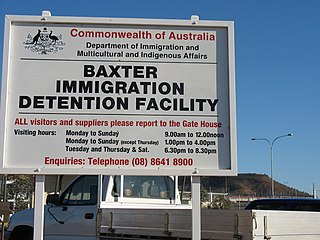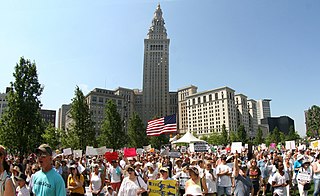
The Woomera Immigration Reception and Processing Centre (IRPC) was an Australian immigration detention facility near the village of Woomera in South Australia. It was opened in November 1999 in response to an increase in unauthorised arrivals, which had exceeded the capacity of other detention facilities. It was originally intended to hold 400 people, however at its peak in April 2000 it had nearly 1,500 detainees. After ongoing public pressure in response to several well publicised riots from 2000, accusations of human rights abuses, and capacity issues, the centre closed in April 2003.
Australian immigration detention facilities comprise a number of different facilities throughout Australia. They are currently used to detain people who are under Australia's policy of mandatory immigration detention. Asylum seekers detected in boats in Australian waters have been detained in facilities on the offshore islands of Nauru and Manus Island, previously under the now defunct Pacific Solution and under Operation Sovereign Borders.

The Nauru Regional Processing Centre is an offshore Australian immigration detention facility in use from 2001 to 2008 and from 2012 to 2019, and set for reuse from September 2021 after a new agreement was signed between the governments of Nauru and Australia. It is located on the South Pacific island nation of Nauru and run by the Government of Nauru. The use of immigration detention facilities is part of a policy of mandatory detention in Australia.
Cornelia Rau is a German and Australian citizen who was unlawfully detained for a period of ten months in 2004 and 2005 as part of the Australian Government's mandatory detention program.

Baxter Immigration Reception and Processing Centre or commonly just Baxter Detention Centre, was an Australian immigration detention facility near the town of Port Augusta in South Australia. It was the focus of much of the controversy concerning the mandatory detention of asylum seekers in Australia.
The Serious Organized Crime and Police Act 2005 (c.15) is an Act of the Parliament of the United Kingdom aimed primarily at creating the Serious Organised Crime Agency. It also significantly extended and simplified the powers of arrest of a constable and introduced restrictions on protests in the vicinity of the Palace of Westminster. It was introduced into the House of Commons on 24 November 2004 and was passed by Parliament and given Royal Assent on 7 April 2005.
The Sixth Ministerial Conference of the World Trade Organization, also known as the WTO Hong Kong Ministerial Conference and abbreviated as MC6, was held at the Hong Kong Convention and Exhibition Centre, Wan Chai, Hong Kong from 13 to 18 December 2005. Representatives from 148 countries were expected to attend the event, as well as over 10,000 protesters led by the Hong Kong People’s Alliance on WTO and made up of largely South Korean farmers. Wan Chai Sports Ground and Wan Chai Cargo Handling Basin in Wan Chai North have been designated as protest zones. Victoria Park served as the starting point for the rallies. Police wielded sticks, used gas grenades and shot rubber bullets at some of the protesters. They arrested 910 people, 14 were charged, but none were convicted.

Plane Stupid is a UK-focused group of environmental protesters who state their aim as wanting to see an end to airport expansion for what it sees as "unnecessary and unsustainable" flights. It is a loose association of autonomous regional groups, and is funded by donations.

Otago University NORML is a pro cannabis law reform student club at the University of Otago, affiliated to the Otago University Students Association. It is a local chapter of the national New Zealand cannabis law reform organisation NORML New Zealand, an affiliate of the National Organization for the Reform of Marijuana Laws (NORML).

Christmas Island Immigration Reception and Processing Centre or commonly just Christmas Island Immigration Detention Centre, is an Australian immigration detention facility located on Christmas Island in the Indian Ocean.
Center Sandholm, or Sandholm, is a public institution for asylum seekers in Denmark. It is located in Sandholm, Blovstrød, Allerød Kommune. Children and young people under 18 who have fled alone are received at Center Gribskov. It is a former military barracks and the largest reception center for asylum seekers in Denmark. The center's daily operations are run by the Danish Red Cross. It also serves as both a receiving and departure center, for newly arrived asylum seekers, and asylum seekers who have been rejected; however, this later group will eventually be moved over to the Sjælsmark deportation camp. Separated from the Red Cross facility, Sandholm also offers a branch of the Immigration Service, the National Police Immigration Department, and Ellebæk, a penal institutions for detained asylum seekers.
Australian League of Immigration Volunteers was an Australian charity. Its main work focused on improving the lives of refugees through volunteering in Australian detention centres. ALIV was the only Australian charity that conducted programs within all immigration detention centres across Australia. ALIV was threatened with deregistration early in 2011, after speculation that it was being run on the principles of Scientology.
Nakba Day in 2011 was the annual day of commemoration for the Palestinian people marking the Nakba—the displacement that accompanied the creation of Israel in 1948. Generally held on May 15, commemorative events in 2011 began on May 10, in the form of march by Palestinian Arab citizens of Israel on Israel's Independence Day. On May 13, clashes between stone-throwing youths and Israeli security forces in East Jerusalem resulted in one Palestinian fatality, and clashes continued there and in parts of the West Bank in the days following.

The Manus Regional Processing Centre, or Manus Island Regional Processing Centre (MIRCP), was one of a number of offshore Australian immigration detention facilities. The Centre was located on the PNG Navy Base Lombrum on Los Negros Island in Manus Province, Papua New Guinea.

The 2015 European migrant crisis, also known internationally as the Syrian refugee crisis, was a period of significantly increased movement of refugees and migrants into Europe in 2015, when 1.3 million people came to the continent to request asylum, the most in a single year since World War II. Those requesting asylum in Europe in 2015 were mostly Syrians, but also included significant numbers of Afghans, Nigerians, Pakistanis, Iraqis and Eritreans, as well as economic migrants from the Balkans.

Migrants have gathered in and around Calais, on the northern French coast, since at least the late 1990s seeking to enter the United Kingdom from the French port by crossing the Channel Tunnel or stowing away in the cargo area of lorries heading for ferries that cross the English Channel. During this time, informal camps of migrants have formed, the most notorious commonly referred to as the Calais Jungle. Other migrants come to the area because they are homeless while seeking asylum in France. The presence of migrants in and around Calais has affected the British and French governments, the Eurotunnel and P&O Ferries companies, and lorry drivers heading for the UK and their companies. EuroTunnel, the company that operates the Channel Tunnel, said that it intercepted more than 37,000 migrants between January and July 2015.

This is a timeline of the European migrant crisis from 2004 to the present. It lists migrant boat shipwrecking events from 2004 to 2015. From 2015 to the present, it also lists events connected with land migration and countries' political reactions related to the European migrant crisis and part of which is the Ukrainian refugee crisis.

Protests against the Trump administration family separation policy are a reaction to the Trump administration policy of separating children from their parents or guardians who crossed the U.S. border either illegally or to request asylum, jailing the adults and locating the minors at separate facilities under the care of the Department of Health and Human Services.
The Fort Chaffee crisis occurred during the Mariel boatlift in 1980 when over 19,000 Cuban refugees were detained at Fort Chaffee. They could not be released into the public because they were not United States citizens. After a promise of quick release many processing setbacks occurred and many refugees remained still detained at the center. Frustrated with the conditions at the facility and the slow processing many refugees rioted, 62 refugees were injured and 46 others were arrested. Refugees at the center would go on to refer to the riot as El Domingo. After the riots Governor Bill Clinton put heavy fortifications at the center. Clinton would lose the later Arkansas election after his opponent would use the incident against him.

San Uk Ling Holding Centre is a detention centre in Man Kam To, New Territories, Hong Kong. It is located in a remote area, a few hundred metres from the Man Kam To Control Point, a border crossing facility between Hong Kong and China. San Uk Ling Holding Centre opened in July 1979 to house illegal immigrants prior to their repatriation.











